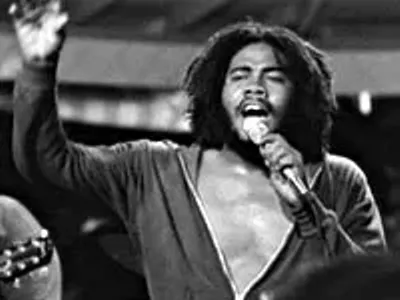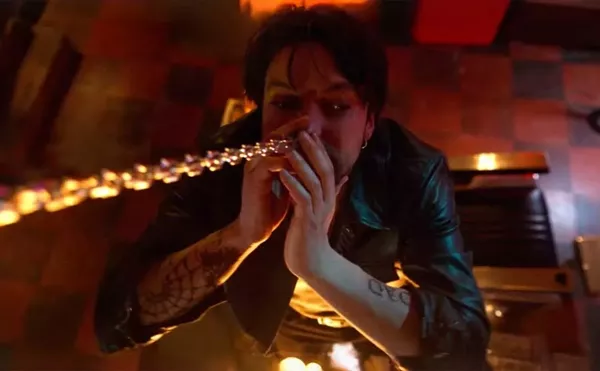
Audio By Carbonatix
[
{
"name": "GPT - Leaderboard - Inline - Content",
"component": "35519556",
"insertPoint": "5th",
"startingPoint": "3",
"requiredCountToDisplay": "3",
"maxInsertions": 100,
"adList": [
{
"adPreset": "LeaderboardInline"
}
]
}
]
Newton’s 62 small mixed-media drawings hanging in the back room/gallery of Book Beat in Oak Park is the occasion for a meditation on the structure of the world, on the shadow side of light or, in this case, on the fantastic forms that exist on the dark side of "The Old Church Window." The press release for the exhibition briefly explains that the subject for these speculative and fragile sketches is "from the famous Kirkstall Abbey in England," a 12th century Cistercian monastery outside of Leeds in northern England. Whether or not they were done there is not explained. Suffice it to say that the constant feature of these layered expressionistic renderings of the shadow interior of (presumably) the Kirkstall Abbey is a small, blue square at the center of perspective in each piece. This small "window" organizes not only the drawn space, but the psychological disposition of our vantage point toward reality.
Executed on the green paper of a traditional stenographer’s notebook, most of the drawings are composed in a black inky medium, perhaps powdered pigment, and paint in vertical and horizontal lines that accumulate into a dark architectural grid around the blue window (pictured). The contrast of the blue "sky" of the (at times) barely perceptible window with the shadow darkness of the surrounding "architecture" suggests metaphors of emancipation as well as spiritual confinement.
Some of the drawings include collaged elements such as text, floor plans and in one case a small image of what appear to be Chinese monks, as well as human figures that suggest further metaphorical relationships between our lives and our built spaces of protection and confinement. The easy-on-the-eye green of the paper on which the drawings are done is a magical counterpoint to their subject.
Complementing the quick and rough aesthetic of Newton’s drawings is an exhibition of the archives of "Nightcrawlerz: The Third Mind 1981-1990," an art collaboration of Cary Loren and Barry Roth. Loren, after parting ways with Destroy All Monsters, the art collective of which he was a founding member, joined with poet Roth to form Nightcrawlerz, a kind of laboratory of aesthetic investigation centering around eight issues of a magazine that featured poems, "sound-based cut-up collages" and photographs. Their art and literary production was clearly inspired by the cut-up method of Brion Gysin and William Burroughs, the surrealist strategies of André Breton, and most significantly the brilliant poetic mind and work of "mail artist" Ray Johnson with whom they collaborated. Small, post-cubist, wooden sculptures and drawings are included in the exhibition, as well as photo collages bearing a formal resemblance to Newton’s drawings.
A project that’s a model of poetic investigation and experimentation, "Nightcrawlerz" shares a common aesthetic with such figures as Ed Sanders (the poet who edited Fuck You: A Magazine of the Arts and was a founding member of the band the Fugs) as well as another one-man poetry machine and publisher, Detroiter Maurice Greenia, whose work is currently featured in a show at ZeitGeist Gallery. Modest in its documentary aspirations and impact, "Gordon Newton: The Old Church Window" and "Nightcrawlerz" is a dual exhibition worth looking at in the best bookstore in metro Detroit.
Book Beat is at 26010 Greenfield Road in Oak Park; call 248-968-1190. Glen Mannisto writes about visual art for Metro Times. E-mail him at letters@metrotimes.com





